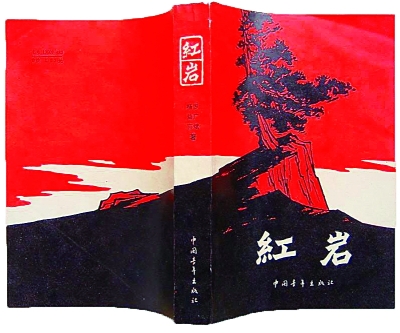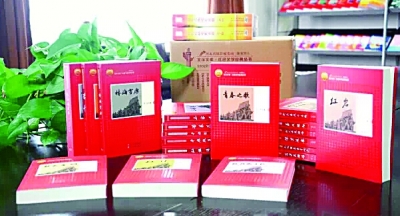Red literary works: heroic images deeply rooted in people’s hearts


In the history of contemporary literature in China, there is a saying that "three reds and one creation, the mountains are green and the forests are protected", which refers to eight novels that were created in the 1950s and 1960s and had a great impact on society, namely Red Rock (Luo Guangbin and Yang Yiyan), Red Sun (Wu Qiang), Red Flag Spectrum (Liang Bin), Entrepreneurship History (Liu Qing) and. These novels are different from other classic works born in the same period, such as the novel Fight to Tomorrow (White Blade), Iron Wall (Liu Qing), The Story of the Wind and Cloud (Sun Li), flying tigers (Knowing Xia), Spring and Autumn in a Small Town (Gao Yun Lan), Fighting Youth (Xue Ke) and Wildfire Spring Breeze Fighting the Ancient City.
Epic and heroic character are the most striking features of these red literary classics. With a strong sense of epic and a high degree of artistic generalization, they respectively reflect the arduous struggles during the period of new-democratic revolution and socialist revolution and construction from different aspects and angles, and truly show the glorious and arduous course that China people have gone through under the leadership of the Communist Party of China (CPC) in various historical periods, which has profound educational significance and strong inspiration. Therefore, in the history of contemporary literature in China, these works are also called "revolutionary historical novels".
The authors of "revolutionary historical novels" are mostly the witnesses of the revolutionary history they tell. Just as Tie Ning, chairman of Chinese Writers Association, summarized the revolutionary career and literary career of Xu Guangyao, the author of Fire in the Plain and Private Zhang Ga, they "did not go to the battlefield for writing, but stood at the crossroads of life and death with the people of China in that era filled with blood and fire". And those difficult and tortuous revolutionary experiences provided them with a steady stream of life energy. "As long as you pick up a pen and let your thoughts go back to that era, you can regain your strength and live and write tenaciously with a hundred times of courage and will. It is in this sense that writing presents its value higher than life. "
The red classics have left us many familiar heroes and shining images of Communist party member. Song of Youth is full of youthful elegance and intellectual woman Lin Daojing who bravely pursues democracy and freedom. Jiang Jie, a revolutionary martyr who endured torture, was unyielding, cherished lofty ideals and was not afraid of sacrifice in Red Rock; Liang Shengbao &hellip, an ordinary worker who is hardworking, simple and persevering in the History of Entrepreneurship, insists on starting a business despite hardships; … These lifelike heroes show us the indomitable and heroic revolutionary spirit of the Chinese nation. With the red classic works deeply rooted in people’s hearts, these outstanding images of communist party member have inspired generations to struggle for communist ideals and beliefs.
In addition to the magnificent novels, writers have also left many famous literary works of other genres. Writers such as Sun Li, Ru Zhijuan, Serina Liu, Jun Qing and Wang Yuanjian have incorporated more personal perspectives and personal experiences in their short stories, such as Memories of the Mountain (Sun Li), Lily (Ru Zhijuan), Riverside at Dawn (Jun Qing), Party dues (Wang Yuanjian), Music of Heroes (Serina Liu) and Wan.
Poets such as Ai Qing, Li Ji, Li Ying, Cang Kejia, Yan Chen, Zhang Zhimin, Ruan Zhangjing, Guo Xiaochuan, Wen Jie and He Jingzhi joined in the chorus of praise for the Communist Party of China (CPC), China Revolution and New China, such as To the Sun (Ai Qing), To Kunlun (Li Ji), Li Dazhao (Cang Kejia) and Zhanghe Water (Ruan Zhangjing Qing Sha Zhang (Guo Xiaochuan) and Love Song of Turpan (Wen Jie) have all become famous works. It is worth mentioning that He Jingzhi’s Song of Lei Feng has played a special role in praising Lei Feng, an outstanding Communist party member in new China.
In terms of prose, reportage and newsletter features, in addition to "Remember a spinning wheel" (Wu Boxiao), "Who is the cutest person" (Wei Wei) and "The example of the county party secretary — — Jiao Yulu (Mu Qing, fengjian, Zhou Yuan) and other works, the large-scale series single spark can start a prairie fire and the large-scale series Red Flag Fluttering have also become unforgettable memories for a generation. The former clearly and completely reflects the history of the birth, struggle, growth and development of the People’s Liberation Army, while the latter specifically publicizes the history of the glorious struggle of the people of the Communist Party of China (CPC) and China to young readers, eulogizes the martyrs and heroes in China’s previous revolutionary struggles in the past hundred years, and encourages the younger generation to March bravely into infinitely beautiful socialism.
Since the beginning of the new era, the literary creation with red theme has still set off a wave again and again, and has been explored and expanded in the new era background, resulting in Oriental and Red Ribbon on the Earth (Wei Wei), Garland under the Mountain (Li Cunbao), Bright Sword (Dou Liang), Historical Sky (Xu Guixiang) and Liberation War (Wang Shuzeng).
(Reporter Rao Xiang)